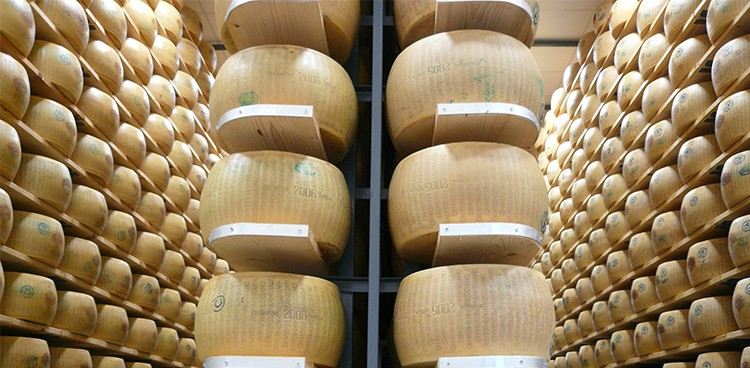
Finance has never made much sense to me, but a financial institution in Italy is doing a pretty good job piquing my interest and understanding in the matter.
Credito Emiliano, or Credem, accepts wheels of Parmigiano Reggiano as a form of collateral against the loans of farmers. At face value, that might seem preposterous. After all, people normally assume banks are storing bars of gold in their protected vaults, not large wheels of cheese. But however counterintuitive it may seem to put so much stock in a perishable dairy product, the practice has proven itself a success for Credem. In fact, cheese-based loans have been a well-known practice for many years, dating back to the Medici era. The practice fell out of fashion after the Renaissance, but as Good Magazine recently discovered, Credem reinstated cheese-based loans in 1953.
If you’re still unconvinced, let me explain how the process works.
Parmigiano Reggiano is a hard cow’s milk cheese usually made in wheels of up to 100 pounds. It takes at least two years for the cheese to mature and reach its prime for consumption. If aged for the proper time period, the cheese taste nutty, sweet, grassy, and slightly fruity. Unfortunately, the long and delicate aging process means high costs on things like staff salaries, cattle feed, and maintenance. This is where the problem arises—a lag between high production costs and the big payoff from selling a matured cheese. In order for farmers to continue running their operations, they need loans to help them until the cheese can be sold.
With little else to offer as collateral, farmers are given the chance to offer up young cheese and receive up to 80 percent of its expected value with an interest rate of about three to five percent. The deal is good for two years and the money farmers receive up front usually helps them get through the slow selling periods. Once they’re back on their feet financially, the farmers are welcome to buy back their cheese (and they can usually sell it for about 10 percent profit).
The bank considered all possibilities, of course, and knew to plan for poor circumstances. If a farmer fails to pay back the loan, the bank can sell the aged Parmigiano Reggiano at market price, earning back at least 20 percent more than they loaned out in the first place. It turns out that over the years, Credem has actually perfected its aging process. It is cheaper for them, rather than the small farmers, to carry out the arduous aging process. This means that farmers can rest assured that the cheese will be cared for and can be safely repurchased in a condition ready for the market.
Not only has this creative credit process served the bank well, but it has helped traditional farmers in Italy survive and continue to provide the prized cheese. For a while, the Parmigiano Reggiano industry was looking grim. Between 2008 and 2013, 100 farms in the Emilia-Romagna region closed for good. But as word of Credem’s loans spread, so did luck for the 400 remaining farms in that region. Since 2013, these farmers have stocked over $250 million worth of the cheese in Credem’s cheese vaults.
The practice has proven so successful that Italian officials are considering employing similar tactics with prosciutto and fine regional wine. Now this is the kind of banking I approve of.



